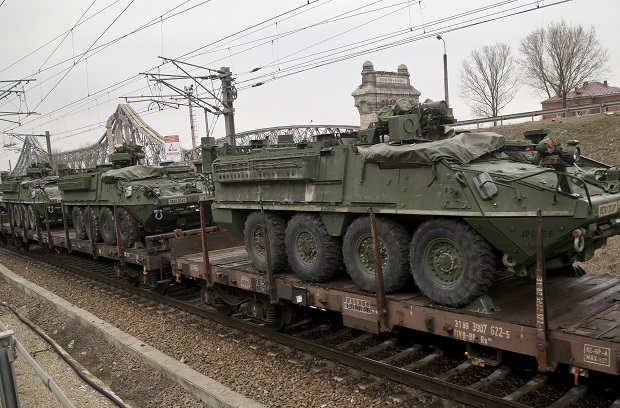NATO fears crippling Russian attack

US military armored vehicles are transported on a freight train near the Black Sea port of Constanta, Romania, in this March 15, 2015 photo. NATO allies are boosting its presence on its western frontier for fear that a Russian attack could cut off former Warsaw pact nations from the rest of Europe. AP
WARSAW, Poland — Lakes, forest and villages dot the rolling hills along Poland’s 65-kilometer (40-mile) stretch of border with Lithuania, but for NATO’s top brass, this bucolic landscape gives cause for sleepless nights.
Sandwiched between Russia’s highly militarized Kaliningrad exclave and Belarus, strategists dub the idyllic stretch of countryside the Suwalki Gap.
They warn it is the Achilles’ heel of NATO’s eastern flank: its capture would amputate the alliance’s three Baltic members and so shatter its credibility.
Fears that Russia could attempt an attack surged after Moscow’s 2014 annexation of Crimea from Ukraine, a move which sent East-West relations to their lowest point since the Cold War.
NATO’s biggest ever war games in Eastern Europe — June’s Anaconda maneuvers in Poland — focused partly on defending the Gap, amid what one analyst dubbed “sophisticated” and “intimidating” exercises in Kaliningrad and Belarus.
Article continues after this advertisement“Russia could take over the Baltic states faster than we would be able to defend them,” the commander of US ground forces in Europe, General Ben Hodges, admitted to Germany’s Die Zeit weekly.
Article continues after this advertisementA Rand Corporation war games report issues the same stark warning: “The longest it has taken Russian forces to reach the outskirts of the Estonian and/or Latvian capitals of Tallinn and Riga, respectively, is 60 hours.”
John Deni, a research professor at the US Army War College Strategic Studies Institute, says the West’s main concern “is that Russia would close” the Gap using a combination of ground forces from Kaliningrad and Belarus, or “air, tactical missile, or artillery assets based in Kaliningrad”.
Such moves “would likely lead to a broader war between Russia and the West,” he warns.
New arms race?
Leaders at NATO’s landmark summit in Warsaw on Thursday and Friday want to prevent that.
As part of the largest alliance revamp since the Cold War, they are set to deploy four multinational battalions to the Baltic nations and Poland on a rotational basis.
Dubbed NATO’s “enhanced forward presence” and billed by the US-led alliance as part of a purely defensive “deter and dialogue” strategy, each battalion will have 600-1,000 troops.
“Polish forces are well prepared to effectively defend it (Suwalki Gap), but of course there aren’t enough of them, given Russia’s full mobilization. This is why (NATO) battle groups are necessary,” Polish Defense Minister Antoni Macierewicz told foreign press in Warsaw days ahead of the summit.
Macierewicz also said he was beefing up Polish forces in the area.
Unconfirmed local media reports say Britain will lead a battalion in Estonia, Canada in Latvia, and Germany in Lithuania, while the US is expected to do so in Poland.
“We have made a very clear link between the presence of the battle groups in Poland and in the Baltic states,” Tomasz Szatkowski, Polish defense ministry undersecretary of state, also told foreign media in Warsaw.
“Most likely, it (battle group in Poland) will be in the proximity of the Suwalki Gap, in a location that allows them to very quickly secure it.”
Separately, the Pentagon said in March it would deploy an additional armored brigade of about 4,200 troops in eastern Europe from early 2017 on a rotational basis.
Moscow fiercely opposes Western expansion in what it sees as its Soviet-era backyard and in 1997, NATO formally agreed not to install permanent bases in former Warsaw Pact states.
The Kremlin has stepped up its presence in the Baltic Sea area and its jets frequently test the airspace of NATO allies such as Estonia.
It plans to create three new divisions in its southwest region and deploy new arms to meet what it described as a dangerous military build-up along its western borders.
‘Cold War is history’
Last week, Russian President Vladimir Putin accused NATO of tearing up the military balance in Europe and triggering a new arms race, although alliance chief Jens Stoltenberg has long insisted “the Cold War is history and we want it to stay that way”.
Poland’s Szatkowski cast doubt on Putin’s posturing, explaining that “the enhanced forward presence will not be something that by its own combat potential will be able to defend the whole theater”.
“The bottom line is that it will significantly increase our security and reduce the probability of some unwanted incidents,” he added.
Minister Macierewicz also said non-members Finland and Sweden would attend the Warsaw summit to “deepen relations”, something analysts note reinforces Baltic regional security.
Macierewicz also signaled a “deepening of cooperation” between NATO and the EU with the inking of a “joint declaration and mutual support especially regarding hybrid threats.”
Poland plans to enroll volunteers in a 35,000-member paramilitary force intended to counter a perceived hybrid warfare threat from Russia.
Russia’s tactic is based on deception rather than a formal declaration of war, NATO strategists say.
They suggest Russia used it to annex Crimea by covertly deploying unidentified troops and to engineer the pro-Moscow revolt in eastern Ukraine that followed.
Warsaw will use these new “territorial defense forces” to expand its armed forces next year to 150,000 men from the current 100,000.